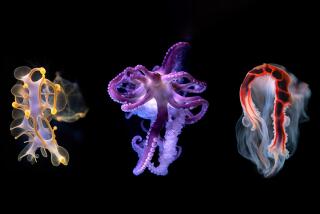Q&A: Sign spinners as performance art: Doug Aitken’s ‘happening’ Saturday
Doug Aitken’s solo exhibition of new work at Regen Projects, “Still Life,” may be about crystallization amid quick-shifting landscapes, both physical and ideological, but the artist himself is still very much on the move. In conjunction with the show, which closes Oct. 11, Aitken will stage a performance and site-specific “happening” across the street from the gallery from 4 to 8 p.m. Saturday.
The artist hired 17 professional sign spinners to stand along Santa Monica Boulevard for four hours and twirl signboards. Each features a short phrase he’s crafted, such as “Clouds roll rapidly” or “I have no memory.”
Last year Aitken famously led a caravan of vintage train cars filled with artists and musicians across the country, staging “happenings” in public locations along the way as part of his “Station to Station” project. He also was the vision behind the Museum of Contemporary Art’s “The Artist’s Museum Happening” in 2010.
During the last two hours of the Saturday performance, which Aitken conceived but is not actually in, the gallery will host a book signing of “Doug Aitken: 100 YRS,” the artist’s most comprehensive monograph to date, published by Rizzoli this year.
What can we expect to see in the upcoming performance and what’s it about?
I wanted to create a cultural ambush of a sort. This is a street that we drive on all the time, and we reach the point where we don’t see things any more, we don’t notice the landscape. I wanted to disrupt that, to insert ideas and questions into that everyday landscape of strip malls, liquor stores and intersections. It’s also about motion, speed, acceleration -- the movement of the signs will make a very beautiful synchronicity with the traffic and street life it merges with.
How does this “happening” tie in with your Regen Projects show, which is largely about stillness, rather than motion? Are you juxtaposing ideas?
It is a juxtaposition between the two, but there’s also a similarity -- both deal with signs and symbols. The show is really about slowing them down so that the signs and symbols become something the viewer can come back to and have a dialogue with. The happening is in the opposite direction -- it’s inserting these ideas back into the commercial landscape, ideas that are usually commercial but in this case are philosophical.
How do you imagine viewers will interact with the public performance?
The work explores the landscape in the present and moving into the future. I wanted to work with words and language in the piece to provoke questioning of the familiar landscape around us. Each of the signs is a fragment of words, and as they’re spinning and moving down the street they’ll create different combinations viewers can make their own. The constant flow of words and phrases can mean one thing -- on their own they’re almost like an electronic haiku, but they have many different meanings as you follow their motion and movement down the street.
Sign spinning is, itself, a kind of bizarre manifestation of the modern urban and commercial landscape. What intrigues you about it?
I wanted to collaborate with sign spinners -- men and women we see at intersections all the time often spinning ads for 1-800 or bankruptcy or products -- and in this situation take their work in a different direction. I wanted to elevate their choreography and allow it to be seen as something other than commercial.
What they do is amazing, but it’s only positioned to sell things. The performance uses this interesting skill, like modern dance or choreography, but the meaning changes and becomes interesting as it breaks out of the capitalistic system. In this case there’s nothing to be sold.
What is it about public art “happenings” that inspires you so much?
There’s always a sense of the unexpected. I’m really interested in happenstance, almost like an ambush. Someone just passing by that didn’t know anything about it, and they just come across something. It’s also about people using tools in a different way -- in this case, sign spinning becomes something interesting when it’s taken out of its capitalistic system.
Twitter: @debvankin
More to Read
The biggest entertainment stories
Get our big stories about Hollywood, film, television, music, arts, culture and more right in your inbox as soon as they publish.
You may occasionally receive promotional content from the Los Angeles Times.











